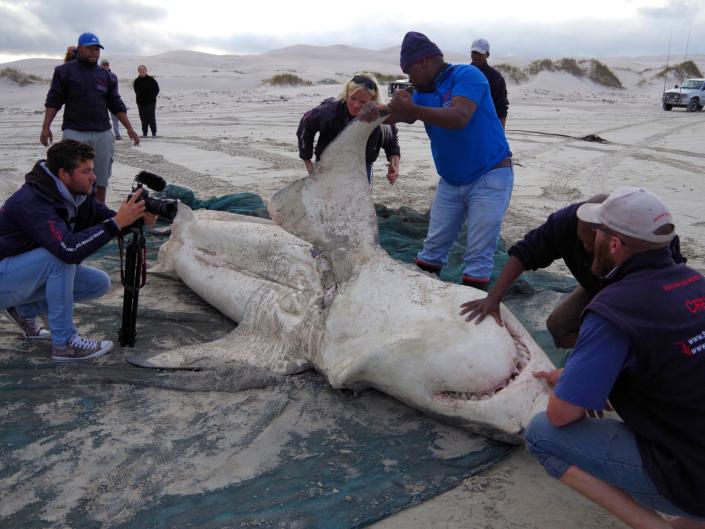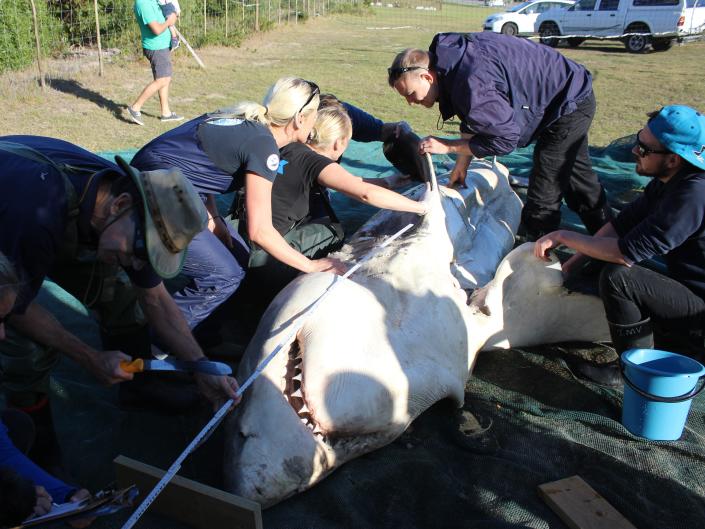A pair of orcas are hunting great white sharks to eat their livers, causing the species to flee the coast of South Africa

A pair of orcas are preying on great white sharks off the coast of South Africa, according to a new study.
The orcas have ripped out the livers and hearts of great white sharks, the study said.
In response to the attacks, the study said that the great white sharks are migrating en masse.
A pair of orcas has been terrorizing great white sharks off South Africa's coast since 2017, causing them to flee en masse, according to a new study.
The study, published in the African Journal of Marine Science, suggests the menacing orcas might have scared great white sharks away from their habitat on the Gansbaai coast on South Africa's Western Cape.
A team of researchers from Marine Dynamics and the Dyer Island Conservation Trust noticed that over five and a half years, 14 sharks had been tracked fleeing the area in which the orcas are present.
Visual sightings of the great white sharks have also decreased, per the study.
Using tagging data and long-term sightings, researchers also noticed that great white sharks had started washing ashore.
Eight great white sharks washed ashore between 2017 and 2020, according to the data. Seven of them had their livers ripped out, with some also having had their hearts removed, the study said.

The wounds are distinctively made by the same pair of killer whales, according to the study. The orcas are likely to have killed more sharks that are yet to wash up ashore, the study said.
The attacks have triggered the sharks' "flight" instinct, causing a mass migration away from the marine predators, according to the study.
Alison Towner, a senior white shark biologist at the Dyer Island Conservation Trust, said: "What we seem to be witnessing though is a large-scale avoidance strategy, mirroring what we see used by wild dogs in the Serengeti in Tanzania, in response to increased lion presence."

Towner continued: "The research is particularly important, as by determining how large marine predators respond to risk, we can understand the dynamics of coexistence with other predator communities."
Towner observed that the decrease in the number of great white sharks has other effects on the sea's fragile ecosystem. It has triggered an emergence in the area of the bronze whaler shark, which the great white shark typically eats, Towner said. These sharks, however, are also being targeted by orcas, per the study.
Insider previously reported the first evidence on a pod of orcas hunting and killing adult blue whales.

Marine scientists from Cetrec WA (Cetacean Research) were able to detail how orcas swam inside the mouth of blue whales to eat their tongues. Researchers saw large chunks of skin and blubber having been gouged from the body of a blue whale and most of the dorsal fin having been bitten off, Insider's Bethany Dawson reported.
Great White Sharks Are Completely Terrified of Orcas
A new study shows the apex predators will flee their hunting grounds and won’t return for up to a year when killer whales pass by
Jason Daley
SMITHSONIAN
Correspondent
/https://tf-cmsv2-smithsonianmag-media.s3.amazonaws.com/filer/ed/7f/ed7f68c1-7ebd-421a-8cda-eb5616df0fa7/orca.jpg)
It’s pretty much common wisdom that the top predator in the ocean is the great white shark (that is, if there isn’t a remnant population of megalodon hidden somewhere in the deep). But a new study reveals that the massive shark is not the ocean’s top apex predator: that title rightly belongs to orcas, also known as killer whales.
The revelation comes from a paper in Nature Scientific Reports by senior research scientist Salvador Jorgensen at the Monterey Bay Aquarium and his colleagues. Ed Yong at The Atlantic reports that over the years, while studying great white sharks, Jorgensen and his team began to notice that when killer whales entered the scene, the sharks made an exit, and in many cases did not return for months. In particular, in 2009 the team radio-tagged 17 sharks around Southeast Farallon Island in Greater Farallones National Marine Sanctuary, a marine and wildlife refuge off the coast of California. The sharks happily munched on young elephant seals in the waters around the island, which they regularly do between September and December. But when a pod of orcas entered the waters for just a couple of hours, the sharks high-tailed it out of there and most didn’t return that season.
To understand if that situation was common or the whole thing was a fluke, Jorgensen and his team looked deeper in the data, examining information about 165 great white sharks tagged in the Farallones between 2006 and 2013. They compared that with whale, shark and seal surveys collected in the marine sanctuary collected over 27 years.
What they found was a standard pattern. When orca whales entered the area, the sharks bolted from Southeast Farallon and nearby islands. “When confronted by orcas, white sharks will immediately vacate their preferred hunting ground and will not return for up to a year, even though the orcas are only passing through,” Jorgensen says in a press release.
Sarah Sloat at Inverse reports that if the whales get within two miles of the islands, the sharks will pack up and leave. In an average year, researchers are able to document 40 elephant seals eaten by sharks. But in years where the orcas make an appearance, which they did in 2009, 2011 and 2013, that number drops by 62 percent from the previous year. For the seals it can be a win-win situation. If the whales simply pass by and don’t stop to snack but still clear out the sharks, the young seals can chase fish in relative security.
So why are the sharks, which can grow up to 18 feet long, so afraid of orcas? Yong reports that most of what we know about white shark/orca encounters doesn’t end well for the sharks. In 1997, during the first interaction ever recorded, fishermen near Southeast Farallon witnessed a pair of orcas kill a young great white that tried to nose in on the sea lion they were eating. The orcas bashed him to death then ate his liver.
In 2017, five corpses of great white sharks washed up on the beaches of South Africa, all with their livers almost surgically removed. It was the work of orcas, which kill the sharks then make a wound near the calorie-dense shark liver. They then squish the yummy treat out of the shark and leave the rest of the corpse. “It’s like squeezing toothpaste,” Jorgensen tells Yong.
Researchers are beginning to understand how the instinct to avoid predators creates a “landscape of fear” that can have wide-ranging impacts on ecosystems. This new study shows that the concept also applies in the oceans. “We don't typically think about how fear and risk aversion might play a role in shaping where large predators hunt and how that influences ocean ecosystems,” Jorgensen says in the press release. “It turns out these risk effects are very strong even for large predators like white sharks—strong enough to redirect their hunting activity to less preferred but safer areas.”
Let’s just hope those safer hunting grounds aren’t too close to shore.
Jason Daley is a Madison, Wisconsin-based writer specializing in natural history, science, travel, and the environment. His work has appeared in Discover, Popular Science, Outside, Men’s Journal, and other magazines.
Is A Killer Whale a Shark?
Killer whales are often grouped in with and given a “shark” label because they seem hungry, toothy, and sometimes even violent enough to have been a good understudy for “Jaws.”

Even their name can be considered the scariest one of the larger sea creatures! Saying this, killer whales – also known as orcas – are not sharks at all!
In fact, they are members of the dolphin family.
The Dolphin Family
Before we go into why exactly an orca is a dolphin, it is best to know what makes a dolphin in the first place!

The second fun fact of the day (after the fact that orcas are not sharks) is that dolphins and whales technically belong to the same family.
However, this family has suborders, which allows for a distinct separation between what we consider dolphins and porpoises, and what we consider whales.
The Odontoceti suborder classifies all dolphins and porpoises, including orcas! The Mysticeti suborder is composed of what we believe to be whales.

Additionally, dolphins and porpoises belong to the same subcategory, though there are significantly less species of porpoises than dolphins.
What Makes an Orca a Dolphin?
An orca is technically considered a dolphin due to similar physical characteristics. Orcas are similar to dolphins in that they have teeth, a rounded head and a beak, and streamlined bodies.
Orcas and dolphins both also have what is known as a melon. A melon is a fatty deposit on what we would consider the forehead of the orcas head, and makes their heads look dome-like.
Only dolphins in the Odontoceti subcategory have melons; whales do not. The melon is a really important organ of dolphins and orcas in that it greatly aids in echolocation.
The melon has varying densities throughout, and acts to focus the sound waves before they travel through the water as a form of communication.
Orcas also only have one blowhole. As dolphins have one blowhole and whales have two, this is further proof that orcas belong in the dolphin subcategory.
Killer Whales vs Shark
While killer whales may not be sharks and are in fact dolphins, it is well known that sharks are terrified or killer whales.
Sharks are known to evacuate their hunting areas for times up to one year if they even see a killer whale nearby.
Marine biologists are beginning to rethink their former conclusion that the apex predator of the ocean is the great white shark, and are reassigning that title to the orca.
The reason for this has been observed by many people who have watched shark and orca encounters.
When sharks get in the way of orcas, orcas are known to beat the sharks until they die, and then feast on their livers. Orcas don’t seem to ever eat the rest of the shark.
Takeaways
Orca whales are not sharks by a long shot. If anything, they are very scary dolphins that sharks run at the sight of! Their anatomy also resembles that of a dolphin, albeit a good amount larger.
Saying this, it is important to note that there has never been a recorded fatality of a human-caused by an orca whale attack in the wild.
So while sharks may be afraid of these creatures, there is no reason for you to be so long as you are respectful of them and their environments.
No comments:
Post a Comment